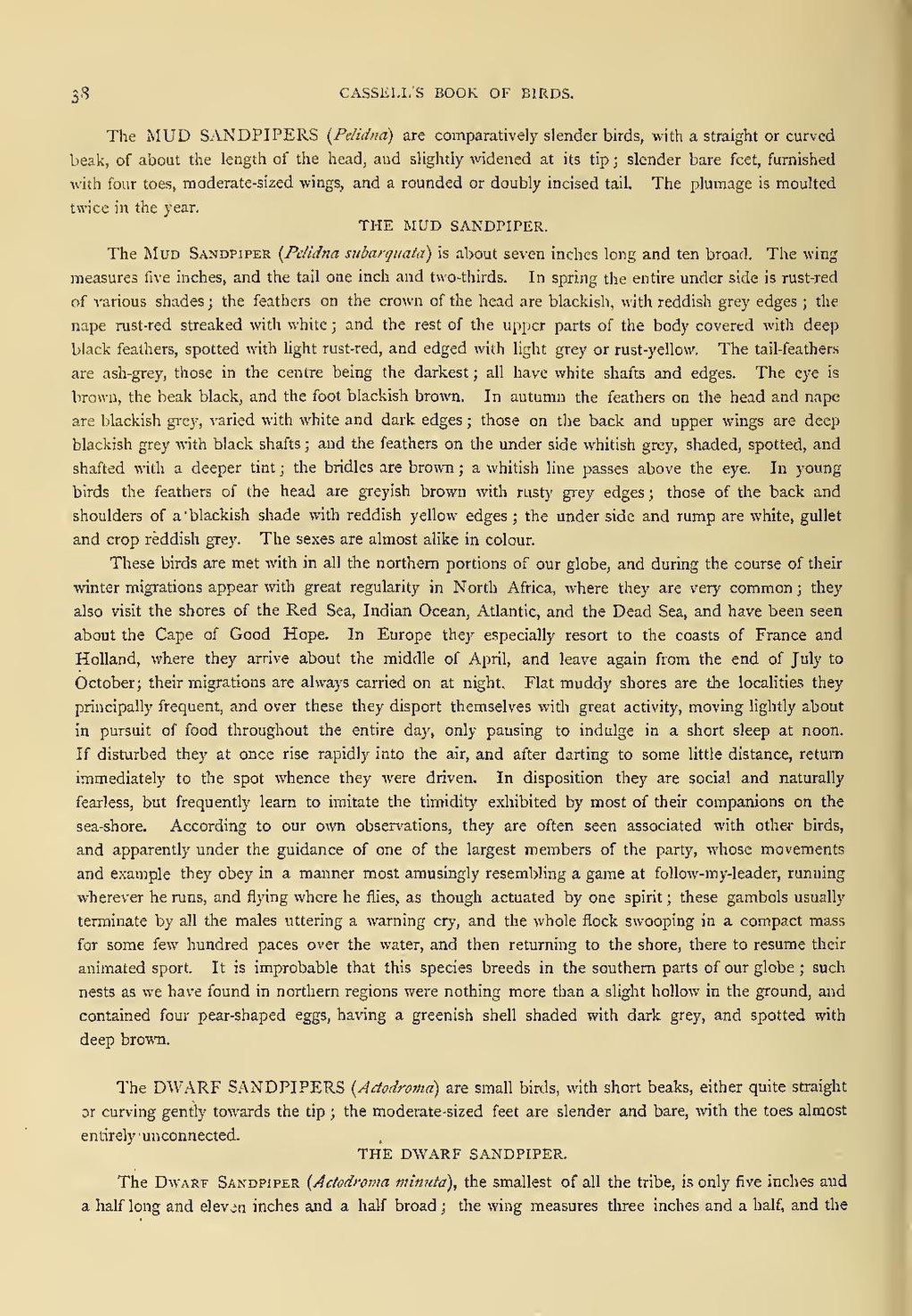<tb>
The MUD SANDPIPERS (Pelidna) are comparatively slender birds, with a straight or curved beak, of about the length of the head, and slightly widened at its tip; slender bare feet, furnished with four toes, moderate-sized wings, and a rounded or doubly incised tail. The plumage is moulted twice in the year.
THE MUD SANDPIPER.
The Mud Sandpiper (Pelidna subarquata) is about seven inches long and ten broad. The wing measures five inches, and the tail one inch and two-thirds. In spring the entire under side is rust-red of various shades; the feathers on the crown of the head are blackish, with reddish grey edges; the nape rust-red streaked with white; and the rest of the upper parts of the body covered with deep black feathers, spotted with light rust-red, and edged with light grey or rust-yellow. The tail-feathers are ash-grey, those in the centre being the darkest; all have white shafts and edges. The eye is brown, the beak black, and the foot blackish brown. In autumn the feathers on the head and nape are blackish grey, varied with white and dark edges; those on the back and upper wings are deep blackish grey with black shafts; and the feathers on the under side whitish grey, shaded, spotted, and shafted with a deeper tint; the bridles are brown; a whitish line passes above the eye. In young birds the feathers of the head are greyish brown with rusty grey edges; those of the back and shoulders of a blackish shade with reddish yellow edges; the under side and rump are white, gullet and crop reddish grey. The sexes are almost alike in colour.
These birds are met with in all the northern portions of our globe, and during the course of their winter migrations appear with great regularity in North Africa, where they are very common; they also visit the shores of the Red Sea, Indian Ocean, Atlantic, and the Dead Sea, and have been seen about the Cape of Good Hope. In Europe they especially resort to the coasts of France and Holland, where they arrive about the middle of April, and leave again from the end of July to October; their migrations are always carried on at night. Flat muddy shores are the localities they principally frequent, and over these they disport themselves with great activity, moving lightly about in pursuit of food throughout the entire day, only pausing to indulge in a short sleep at noon. If disturbed they at once rise rapidly into the air, and after darting to some little distance, return immediately to the spot whence they were driven. In disposition they are social and naturally fearless, but frequently learn to imitate the timidity exhibited by most of their companions on the sea-shore. According to our own observations, they are often seen associated with other birds, and apparently under the guidance of one of the largest members of the party, whose movements and example they obey in a manner most amusingly resembling a game at follow-my-leader, running wherever he runs, and flying where he flies, as though actuated by one spirit; these gambols usually terminate by all the males uttering a warning cry, and the whole flock swooping in a compact mass for some few hundred paces over the water, and then returning to the shore, there to resume their animated sport. It is improbable that this species breeds in the southern parts of our globe; such nests as we have found in northern regions were nothing more than a slight hollow in the ground, and contained four pear-shaped eggs, having a greenish shell shaded with dark grey, and spotted with deep brown.
The DWARF SANDPIPERS (Actodroma) are small birds, with short beaks, either quite straight or curving gently towards the tip; the moderate-sized feet are slender and bare, with the toes almost entirely unconnected.
THE DWARF SANDPIPER.
The Dwarf Sandpiper (Actodroma minuta), the smallest of all the tribe, is only five inches and a half long and eleven inches and a half broad; the wing measures three inches and a half, and the
